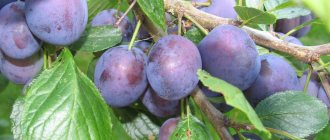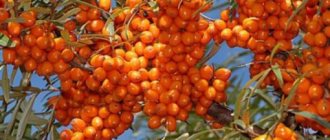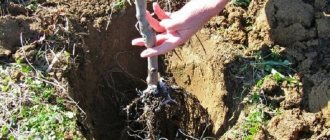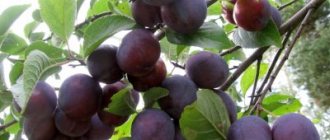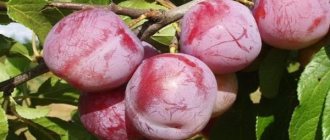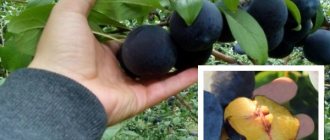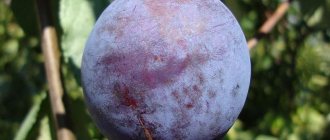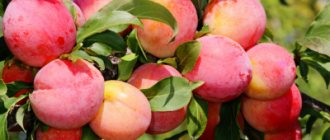Description of plum Yakhontovaya
This variety of plum is a vigorous tree. The crown is compact, spherical; foliage is average. The height of the Yakhontovaya plum reaches 5 m.
The branches are bare, straight, brown. The leaves are elongated, long, with a pointed tip, light green in color. The surface of the leaves is matte and smooth, with small teeth along the edges.
Characteristics of plum fruits of the Yakhontovaya variety:
- yellow;
- thin skin;
- round shape;
- waxy coating;
- weight – 30 g;
- yellow juicy pulp;
- small bone, easily separated;
- sweet and sour taste, rated 5 points.
The Yakhontovaya variety is recommended for planting in the Central region. Due to its high winter hardiness, cultivation in colder climates is allowed.
Reviews
Let’s find out what experienced gardeners think about this plum variety.
- Boris, Ryazan: “I planted the Yakhontova plum 6 years ago, it began to bear fruit in the fourth year. I am pleased with the harvest - the fruits are large, very beautiful, large, juicy and sweet, great for jams, jams, desserts, you can also make liqueur. Care is a little more thorough than other varieties, but nothing too complicated. I cover it for the winter; at least we are considered to be in the middle zone, but the frosts can be severe. The tree still needs to be grafted with dwarf plum species, otherwise it will grow huge and the harvest will not be harvested. Overall, I’m pleased - I’ve never seen such harvests and such tasty plum berries.”
- Alla, Stary Oskol: “I’ve been doing gardening for a long time - I have a residential dacha with a large plot. I have several varieties of plums: Yakhontovaya is my favorite among them. This tree produces such tasty and juicy fruits that it is difficult to resist eating them all at once. Joy for the grandchildren and vitamins for the winter. The plum requires care, but I’m retired, so I mostly work in the garden. It is necessary to water, and feed, and be sure to prune, and it is better to cover for the winter. I recommend this variety, because among the domestic varieties, Yakhontova, in my opinion, has the most delicious fruits.”
Growing marigolds from seeds: timing, rules for planting seedlings, care, picking, planting
It is also worth learning more about existing reviews about the Blue Gift plum.
So, we looked at the features of growing the Yakhontovaya plum variety. As you can see, this brainchild of domestic selection has truly noteworthy properties and characteristics. It’s not without reason that this variety has more and more fans among gardeners every year. Now you can join this chorus of enthusiastic admirers and grow a magnificent Yakhont plum on your plot with the help of our tips.
Characteristics of the variety
Yakhontovaya plum has a number of characteristics that distinguish it from other varieties: winter hardiness, productivity, convenient timing of flowering and fruiting.
Drought resistance, frost resistance
Drought resistance is rated as average. For plums, both a lack of moisture and its excess are detrimental. The irrigation scheme is chosen taking into account weather conditions.
Frost resistance of plums is high. In order for the tree to easily survive the winter, additional shelter is provided in the fall.
Pollinators of plum Yakhontovaya
The Yakhontovaya plum is partially self-fertile. For a better harvest, you need to plant several varieties of plums that bloom at the same time.
Best pollinators:
- Hungarian;
- Red early ripening;
- Memory of Timiryazev.
Important! Early plum blooms from late April to early May. The ripening period for the Yakhontovaya plum occurs in the middle and end of August.
Productivity and fruiting
The Yakhontovaya variety tree bears an average of 20–30 kg of fruit, and in good years – up to 50 kg. Fruiting is regular from year to year.
Area of application of berries
Plums are consumed fresh or used for homemade preparations. It makes delicious preserves, jam, compote, and sauce.
Resistance to diseases and pests
The Yakhontovaya variety is little susceptible to fungal diseases and pests. To protect the garden, it is recommended to periodically spray the trees.
Advantages and disadvantages of the variety
Before planting, evaluate the advantages and disadvantages of the Yakhontovaya plum.
Main advantages of the variety:
- abundant fruiting;
- good taste and appearance of the fruit;
- resistance to frost and disease.
Disadvantages of Yakhontovaya plum:
- impressive dimensions of the tree;
- partial self-fertility.
Is it worth buying a Yakhontova plum?
Yellow plum Yakhontovaya is an excellent option for planting in the Moscow region and other regions of the middle zone. Among its undoubted advantages are high quality fruits and productivity.
Harvest and storage
The Yakhont plum tree is harvested in August. Be sure to do it in dry weather - this way the fruits will retain their marketable appearance longer. Since plums do not ripen simultaneously, harvesting takes place in two or three stages. This will avoid injury or shedding of the fruit.
In premises for storing the Yakhontova plum harvest, special conditions must be observed:
- temperature level up to +2 °C;
- humidity not less than 85%.
Yakhont plum fruits can be stored in wooden boxes or sealed plastic bags.
Landing Features
Its further growth and fruiting depend on proper planting of plums. Preliminarily assess the composition and moisture content of the soil on the site.
Recommended timing
The time for planting the Yakhontovaya plum is chosen taking into account the climate in the region. If there is a risk of early autumn frosts, then the work is left until the spring. Plums are planted when the soil has warmed up, but the leaves have not yet blossomed. In the southern regions, planting is carried out in the fall, when the trees have shed their leaves.
Choosing a suitable location
The place for growing Yakhontovaya plum is chosen taking into account a number of factors:
- constant lighting;
- south or west side of the site;
- light drained soil;
- no moisture stagnation in the soil.
Attention! Plum grows in any soil except acidified soil.
The culture prefers drained fertile soils. The tree should not be located in lowlands where moisture accumulates. A flat area or an area with a slight slope is best suited for plums.
What crops can and cannot be planted nearby?
Plums are planted in groups, 2-3 different varieties. A distance of 3 m is maintained between the trees. The crop does not take root well if pears, cherries and cherries grow nearby. Neighborhood with apple trees, raspberries and currants is allowed.
Selection and preparation of planting material
For planting, choose annual seedlings of the Yakhontovaya variety, about 50 cm high and shoots 2.5 mm thick. They can be purchased from a nursery or garden center.
Comment! First you need to evaluate the plant visually. High-quality material has no damage or traces of mold. If the tree's roots are dry, you can place them in clean water before planting.
Landing algorithm
Work begins with preparing a hole, which is filled with earth and left to shrink. The aging period is 1–2 months. When planting in spring, the pit is dug in the fall. If you plant a plant immediately, then after the soil settles, the seedling will be damaged.
The procedure for planting homemade plum Yakhontovaya:
- First, make a hole measuring 0.6x0.6 m to a depth of 0.7 m.
- Fertile soil is mixed with humus, 190 g of superphosphate and 80 g of potassium salt are added.
- The earth is poured into the hole.
- When the soil settles, they begin to prepare the seedling. Add soil to the hole and place a plum on top.
- The roots of the tree are straightened and covered with fertile soil.
- The soil is compacted and the seedling is moistened with warm water.
Aftercare for plums
Caring for the Yakhontovaya plum comes down to watering, fertilizing and pruning. Preparing for winter will help the tree survive the cold.
- The plum tree is watered 3–5 times per season. Water is especially important if drought occurs during the flowering and ripening period of the crop. 5 buckets of water are poured under a young tree, about 10 buckets under an adult tree.
- It is convenient to combine watering with fertilizing.
In early spring, 20 g of urea, superphosphate and potassium salt are added to 10 liters of water. The solution is poured under the root of the tree. For summer feeding, a similar solution is prepared, but urea is excluded from the composition. Instead of mineral complexes, natural fertilizers are used: slurry and wood ash. Important! Pruning the Yakhontovaya plum helps to form the crown and normalize the yield. - The plum crown is constantly pruned for 5 years. It is given a sparsely tiered form. Be sure to remove dry, frozen and broken branches. Treatment is done in spring or autumn, when sap flow in the trees is slow.
- Preparation of the Yakhontovaya plum for winter begins in late autumn. If the weather is dry, first moisten the soil. Then the trunk is hilled up and compost is poured with a layer of 10 cm. Young plants are covered with burlap or agrofibre. To protect plum trees against rodents, use mesh, metal pipes or roofing felt.
Diseases and pests, methods of control and prevention
Dangerous plum diseases are listed in the table.
| Disease | Symptoms | Treatment | Prevention |
| Fruit rot | Dark spots on the fruit that grow over time. | Destruction of affected fruits. Spraying foliage with Bordeaux mixture. | 1. Weeding, removing root shoots. 2. Trimming shoots. 3. Spraying with fungicides. |
| Coccomycosis | Purple spots on leaves, fruits and shoots. | Spraying plums with copper oxychloride solution. |
You can learn about the main crop pests from the table.
| Pest | Signs | Destruction | Prevention |
| codling moth | The caterpillar eats the fruits, which lose their marketable appearance and fall off. | Spraying trees with a solution of the drug "Chlorophos". | 1. Digging up the soil under a plum tree in the fall. 2. Collecting and burning fallen leaves. 3. Preventive spraying. |
| Silkworm | The caterpillars feed on leaves and buds, leaving nests of cobwebs on the branches. | Destruction of spider nests, spraying with the drug "Entobacterin". |
How to plant
Let us clarify all the important points regarding planting the Yakhontova plum. Indeed, in many ways, the development of a tree and its productivity depend precisely on how, when and where to plant a young seedling.
It is recommended to plant the yakhont plum in early spring, when the sap in the trees has not yet begun to actively flow. But such early spring planting is more suitable for the middle zone, and for southerners it is better to plant plums in the fall.
Choose a place for planting in an area with good lighting. In addition, it is important that the groundwater in the soil does not lie too close - no higher than one and a half meters from the surface. For a tree to feel good, it also needs protection from the winds. If there is no natural barrier, then build an artificial shield that will protect the young seedling from gusts. It is especially important to provide such protection on the north side. This link will tell you about the description of the pear variety.
It is not recommended to plant trees in lowlands, as moisture accumulates in such places. As for the soil, loam is optimal for this variety. Sandy loam soil, as well as soil containing peat, is allowed.
It is necessary to prepare the hole in advance: its width and length should be about a meter, and its depth - half a meter. It is better to prepare the holes in the fall by placing fertilizers in them: then in the spring the soil in them will already be fertile and ready to receive seedlings. Before digging a hole, carefully dig up the entire area, remove debris from it, and remove weeds.
Place the seedling in the hole vertically, strictly in the center. Carefully straighten the roots and sprinkle them carefully with soil mixed with fertilizer. When filling the tree, compact the soil carefully but firmly enough, avoiding the formation of voids and air pockets. The root collar should not be completely covered - it should rise 3-5 cm above the soil surface. Read about the description of the Honey pear variety here.
On the video - how to plant a plum tree correctly:
After the seedling is covered with soil, be sure to water it. Use at least 1-2 buckets of water for the first watering. After watering, it is necessary to mulch the soil along the root circle. Use humus or peat as mulch: these natural substances will best help retain moisture at the roots and also serve as an additional source of nutrition for the plant.
Since the plum seedling is quite weak, it is recommended to tie it to a support. This measure is especially relevant if the weather in your area is often windy.
Let's consider the basic recommendations for caring for the Yakhontova plum.
Watering
The tree requires mandatory watering, but it will not tolerate waterlogging of the soil. It is best to water the plant as needed, depending on the weather and the condition of the tree. If there is no rain, then it is optimal to maintain an interval of 2-3 weeks between waterings. In the summer, provided there is no rain, at least 3-6 liters of water must be poured under the tree during one irrigation procedure.
What the plum Daughter of Sinilga looks like and how it grows, the information at the link will help you understand.
It is worth learning more about the features of growing White honey plum.
You may also be interested in information about the description of the Colonoid Imperial plum variety.
The soil
Yakhontovaya plum does not tolerate highly acidic soils. As experienced gardeners know, any soil can become acidic over time, so periodically test the soil for this parameter. If a high degree of acidification is detected, take measures to neutralize the problem.
To neutralize acidic soil, it is recommended to add slaked lime to the soil once every 4-6 years. Well, if the soil tends to quickly increase in acidity, add lime as often as necessary.
The video shows how to water a plum:
Trimming
Yakhontovaya plum requires mandatory pruning. This procedure will help form the crown of the tree and maintain it in order, and also stop rapid growth in height.
When pruning, it is important to correctly form the crown in order to prevent the formation of many side branches and forks, and also to eliminate the possibility of deviating from a given growth course. The crown, formed properly, resembles a glass.
Sanitary pruning is carried out every spring if diseased, broken, or deformed branches are found. In addition to removing “weak links,” during sanitary pruning, branches that stand out from the overall crown pattern are also removed. It is also worth learning more about pruning the Stanley plum variety.
Top dressing
The plant requires adequate feeding, corresponding to the period of the year, the age of the tree and its needs. In the first year after the seedling takes root in the ground, it is not fed, since all the necessary minerals and organic matter are added to the hole during planting.
In the second year after planting, the plum needs to be fed with nitrogenous compounds. The fertilization procedure should be carried out at the beginning of June and at the end of the same month.
In the third and all subsequent years, 4 additional feedings are applied per season:
- at the end of April - nitrogenous;
- in June - nitrophoska;
- in August - potassium-phosphorus;
- after harvesting - also potassium-phosphorus.
Find out more about growing Eurasia plums, as well as the features of feeding them, in this article.
By following this feeding schedule, you can grow a strong, healthy and abundantly fruiting tree.
Wintering
In the first years after rooting, a young plant requires obligatory shelter for the winter. But you shouldn’t get too fancy with protective structures - the plum will safely overwinter under a layer of peat or fallen leaves. If the winters in the region are snowy, then the plant will overwinter much more safely. And if your area has little snowy winters, make a thicker layer of cover.
The video shows how plums are wintered:
Diseases and pests
Yakhontovaya plum is a fairly strong tree. As a rule, only insufficient tree care and non-compliance with requirements and recommendations lead to diseases and pest damage.
To prevent damage to the tree by aphids, sawflies, moths and other harmful insects, spraying with chemical reagents is recommended. Keep in mind that it is more profitable and reliable to carry out preventive spraying than to treat an infected plum afterwards. And to get rid of most diseases, Bordeaux mixture is used. It should be noted that the Yakhontovaya plum tree does not suffer from viral diseases.
It will also be interesting to learn about what diseases the Morning plum variety may have.
